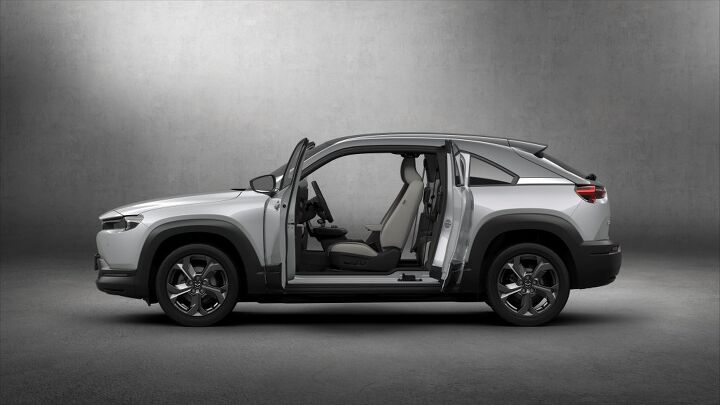Mazda MX-30: Down With Gasoline (and B-pillars)

Mazda put the future on display at the Tokyo Motor Show on Wednesday, unwrapping a battery-electric crossover that thankfully gives us something a little avant-garde to look at.
The brand’s compact EV makes things interesting not by offering a 130-mile range and relatively small battery pack (35.5 kWh), but by employing a team of designers to boost visual appeal in an otherwise bland segment. Kodo design language is front and center here, as is a cabin designed to instill a sense of openness. Materials that only Mazda could get excited about abound. Yet that’s not the MX-30’s most striking feature.
It’s about time another automaker returned to clamshell doors.
The upcoming MX-30, not to be confused with the MX-3 Precidia, dispenses with conventional front-hinged rear doors bolted to the B-pillar in favor of a clamshell configuration, harkening back to such icons as the Mazda RX-8, Saturn Ion Quad Coupe, and Honda Element. Maybe the 2000s weren’t such a bad time for autos?
Currently employed only by the oddball BMW i3 and Ford’s F-150 SuperCab in the mainstream vehicle realm, the door design is something Mazda teased us about earlier in the week. Both side doors swing wide (80 degrees or more), aiding ingress and egress, especially for passengers headed to that wonderfully non-futuristic rear bench. A floating center console frees up more interior volume.
The models specs are less impressive, as 130 miles is barely more than you’d find in a lowly Volkswagen E-Golf or Hyundai Ioniq Electric. Mazda claims the smaller battery pack makes this EV greener than others, as, you know, those rare-earth battery materials don’t just appear out of thin air. As well, there’s a rotary-powered range extender variant on the way, probably bound for the L.A. Auto Show next month. That’s a model Americans might be interested in. Sadly, no word on U.S. availability just yet.
Power from this European-market model amounts to 141 horsepower and 195 lb-ft of torque, sufficient for a compact, front-drive crossover. However, the automaker assures us we’ll hear that power in the cabin, with “aural feedback” provided to enable drivers “to subconsciously recognize the torque status of the power unit and thus control vehicle speed with greater precision.”
Inside the MX-30, you’ll find cork trim sourced from the bark of living trees and door trim cobbled together from old plastic bottles. And, as one would expect, Mazda waxes poetic about the emotions these materials are meant to stimulate. There’s no one-pedal driving, though, as the MX-30’s accelerator pedal can not be used as a brake just by backing off the throttle. Regenerative braking is still present.
While the swap from Skyactiv gas engines to an e-Skyactiv electric powertrain is a big move for Mazda, the brand says its first mass-market electric won’t leave drivers feeling cold. In this model, the brand’s G-Vectoring Control (GVC) becomes e-GVC Plus, modulating the motor’s torque output during wheel inputs for better road manners.
It’s expected that North American customers will see the MX-30 in the near future, but for now, all we can do is stare at this European model sitting in a Japanese auto show and wonder about pricing. Stay tuned.
[Images: Mazda]

More by Steph Willems
Latest Car Reviews
Read moreLatest Product Reviews
Read moreRecent Comments
- Jalop1991 This is easy. The CX-5 is gawdawful uncomfortable.
- Aaron This is literally my junkyard for my 2001 Chevy Tracker, 1998 Volvo S70, and 2002 Toyota Camry. Glad you could visit!
- Lou_BC Let me see. Humans are fallible. They can be very greedy. Politicians sell to the highest bidder. What could go wrong?
- SPPPP Vibrant color 9 times out of 10 for me. There may be a few shapes that look just right in metallic gray, for example. There are a few nices ones out there. And I like VW "White Silver". But I'd usually prefer a deep red or a vibrant metallic green. Or a bright blue.
- 28-Cars-Later Say it ain't so, so reboot #6* isn't going to change anything?[list=1][*]V4-6-8 and High "Tech" 4100.[/*][*]Front wheel drive sooooo modern.[/*][*]NOrthSTARt.[/*][*]Catera wooooo.[/*][*]ATS all the things.[/*][*]We're *are* your daddy's Tesla. [/*][/list=1]






































Comments
Join the conversation
I'm convinced no car company can make the B&B happy. I think this thing looks great except the cladding is a tad over done. Does it lose alot of utility? Sure does, but I think it looks much better than many sub-compact SUVs around. I see the same complaints about the CX-5. Looks great but not enough room. Other Cuvs? More utility...oh but they don't look good. Can't have it both ways.
I'm ambivalent. I don't see any major demerits as far as exterior design goes, but I could see where rearward visibility, especially with the theoretical 3 passengers in the back, could be rather sketchy. The headrests already appear, from the photo, to take up a ton of real estate, and then you had in people, who tend to have heads, and it gets worse. If they market it correctly, as a commuter vehicle for the family who already has another car for longer trips, it could work. However, I'm not in the prediction game, so YMMV. I appreciate the Mazda keeps trying, and is generally bucking the most egregiously stupid design trends. They're small enough that they can still play around a bit. I am curious to see how Toyota's influence will affect them though.